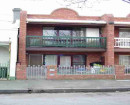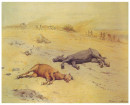FORESTER'S HALL
16 BURKE STREET, SANDFORD, GLENELG SHIRE
-
Add to tour
You must log in to do that.
-
Share
-
Shortlist place
You must log in to do that.
- Download report


Statement of Significance
What is Significant?
The Foresters Hall, located at 16 Burke Road in Sandford was originally built as a Rechabite Hall in 1874. The hall sites adjacent to a Mechanics Institute, built in the late 1880s. Both buildings are located on land reserved for the Mechanics Institute in 1888. The Mechanics Institute and the Forester's Hall are divided by a simple post and wire fence which surrounds each building, breaking the original reserve in two. The hall is a simple single storey red brick building, rectangular in plan. The walls, which are set on a rough stone plinth, are red brick laid in alternating header and stretcher bond on all sides. The south wall has three fine stepped buttresses with windows in the two central bays. The facade has a cement render plaque at the centre of the gable with the letters "A.O.F." still slightly discernable. There is a weatherboard entrance porch at the front centre of the hall with a single rectangular window of two panes and a door on the south side. At the rear there is a rectangular brick section with a gabled roof and a double hung sash window. The rear walls of the hall and this section have been rendered. There is a weatherboard addition with a skillion corrugated iron roof on the north side of the hall. The interiors of the building are simple, with a timber stage at one end, and local hardwood floors.
William Layley, a local shoemaker laid the foundation stone of the Rechabite Hall. John Stewart Anderson, a local saddler planted the Oak tree (Quercus robur) in front of the hall to commemorate the 50th Jubilee of the late Queen Victoria. This tree is dealt with in a separate datasheet as a separate heritage place. Anderson was also a member of the Board of Advice for the South Riding to the Shire of Glenelg, the Sandford Common Committee, the Rifle Club, the Sandford Cemetery Trust, and a foundation member of the Ancient Order of Foresters. He established 'penny readings' and the money raised formed the nucleus of the library later housed in the reading room at the rear of the Mechanics Hall. As secretary of the Institute he called for tenders and James McCormack was the successful tenderer. The building remains in very good condition and retains an excellent degree of integrity.
How is it Significant?
The Foresters Hall is of historical, social and architectural significance to the Glenelg Shire.
Why is it Significant?
The Foresters Hall is of historical significance for the association with important local figures who contributed to the welfare and advancement of the community. It is of social significance as the focus of communal activities, improvement and recreation. The Foresters Hall is of architectural significance for its use of very simple vernacular forms and traditional building techniques using local materials.
-
-
FORESTER'S HALL - Usage/Former Usage
Public Hall
FORESTER'S HALL - Physical Description 1
The Foresters Hall is vernacular in style and has a simple rectangular plan with a gabled roof of corrugated iron. Its plan is approximately 6.0m x 10.0m with a side extension 3.5m x 10.0m. The walls, which are set on a rough stone plinth, are red brick laid in alternating header and stretcher bond on all sides. The south wall has three fine stepped buttresses with windows in the two central bays. The facade has a cement render plaque at the centre of the gable with the letters "A.O.F." still slightly discernable. There is a weatherboard entrance porch at the front centre of the hall with a single rectangular window of two panes and a door on the south side. At the rear there is a rectangular brick section with a gabled roof and a double hung sash window. The rear walls of the hall and this section have been rendered. There is a weatherboard addition with a skillion corrugated iron roof on the north side of the hall. This wing has a double-hung sash window at the back and a newer paired double-hung sash window at the side. There is an early brick chimney in the rear wall. There is evidence of rising damp in the brickwork. The hall and the skillion have cylindrical vents near the ridge of the roof.
There is a large Quercus robur, English Oak on thefront right side of the Foresters Hall, this tree is dealt with in an individual datasheet as a separate heritage place, although it does contribute to the hall.FORESTER'S HALL - Physical Conditions
Good
FORESTER'S HALL - Historical Australian Themes
Theme 4: Building settlements, towns and cities
Theme 8: Developing Australia's Cultural Life
8.5 Forming associations
8.5.1 Preserving traditions and group memories
8.5.2 Helping other people
8.5.3 Associating for mutual aidHeritage Study and Grading
Glenelg - Glenelg Shire Heritage Study Part One
Author: Carlotta Kellaway, David Rhodes Mandy Jean
Year: 2002
Grading:Glenelg - Glenelg Heritage Study Stage Two (a)
Author: Heritage Matters
Year: 2006
Grading:
-
-
-
-
-
COMMERCIAL HOTEL
 Glenelg Shire
Glenelg Shire -
MECHANICS INSTITUTE
 Glenelg Shire
Glenelg Shire -
CALEDONIAN UNION HOTEL (FORMER)
 Glenelg Shire
Glenelg Shire
-
'Boonderoo', House and Outbuildings
 Greater Bendigo City
Greater Bendigo City -
'Riverslea' house
 Greater Bendigo City
Greater Bendigo City -
1 Adam Street
 Yarra City
Yarra City
-
-












